PakAlumni Worldwide: The Global Social Network
The Global Social Network
Nearly 600,000 Pakistanis Migrated Overseas in 2019
Nearly 600,000 Pakistanis have gone overseas for work in the first 11 months of this year, according to figures recently released by Pakistan Bureau of Emigration and Overseas Employment. This phenomenon has helped reduce unemployment in a country where about 2 million young people are entering the job market each year. It has also helped remittances soar nearly 21X since the year 2000.
 |
| Emigrants From Pakistan 1990-2019. Source: Pakistan Bureau of Emigr... |
Migration Overseas:
Over 11 million Pakistanis have left home for employment in Europe, America, Middle East and elsewhere since 1971, according to Pakistan Bureau of Emigration. The pace has particularly picked up over the last 10 years with over half a million Pakistanis migrating abroad each year. This phenomenon has helped reduce unemployment in a country where about 2 million young people are entering the job market each year.
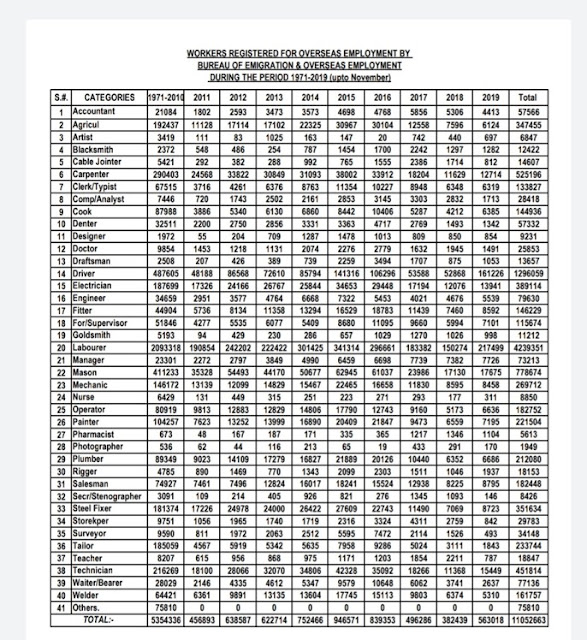 |
| Emigrants From Pakistan 1971-2019. Source: Pakistan Bureau of Emigr... |
More Pakistanis have migrated overseas in the last 9 years (2011-2019) than in previous 30 years (1971-2010). The average figure has been about 500,000 each year since 2011. The highest was 946,571 in 2015 while the lowest was 382,439 in 2018. These figures do not include Pakistanis who went abroad for education and never returned.
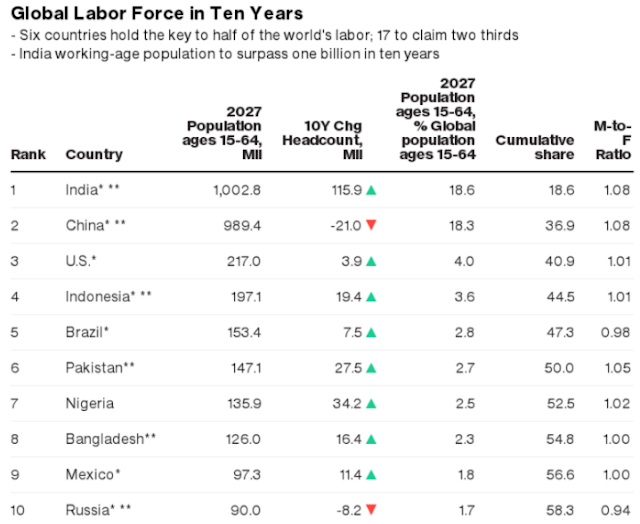 |
Remittance inflows from Pakistani diaspora have jumped 21-fold from about $1 billion in year 2000 to $21 billion in 2018, according to the World Bank. In terms of GDP, these inflows have soared nearly 7X from about 1% in year 2000 to 6.9% of GDP in 2018.
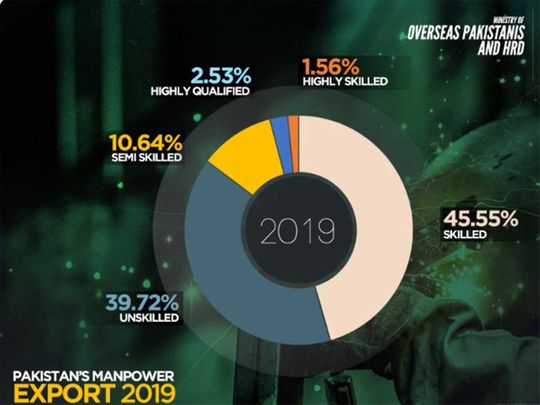 |
| Composition of Pakistan Emigrants. Infographic Courtesy of Gulf News |
Myths About Emigration:
A common myth about emigration is that it is driven by poverty. But the fact is that the poorest and least developed people tend to stay put where they are; they do not migrate. It's only people who have a certain level of income and skills who are more likely to migrate to other countries for better opportunities. This fact has been well-established by multiple studies conducted in Africa.
Here's an except of African Development Bank report on migration:
"Results show that despite increase in the absolute number of migrants, Africa, particularly SubSaharan Africa has one of the lowest rate of emigration in the world .... Poorer countries generally have lower rate of emigration ......Bad socio-economic conditions generally seem to lead to higher rate of emigration by highly skilled individuals. Generally, migration is driven by motives to improve livelihoods with notable evidence on changes in labor market status. Often, self-employed or unemployed émigré ended up in wage employment. The paper outlines policy issues emerging from the migration trend in Africa."
 |
| Migration vs Human Development Source: Hein de Haas |
Data shows that increased human and economic development is initially associated with increasing emigration. Any form of development in the poorest countries of the world is therefore likely to lead to accelerating emigration. Such findings contradict conventional thinking and force us to radically change our views on migration. Such rethinking can be achieved by learning to see migration as an intrinsic part of broader development processes rather than as a problem to be solved, or the temporary response to development “disequilibria”, according to The Conversation, a US publication.
Migration to Non-English Speaking OECD Nations:
Migration data for 2016 released by Organization for Economic Cooperation and Development, the club of rich industrialized nations of Europe, North America and East Asia, shows that a growing number of Pakistanis are migrating to its non-English Speaking member countries. Traditionally, most Pakistanis migrating to rich industrialized nations have preferred to go to English-Speaking nations. The biggest factor driving such migrations appears to be the growing labor shortages caused by aging populations and declining birth rates in OECD member nations.
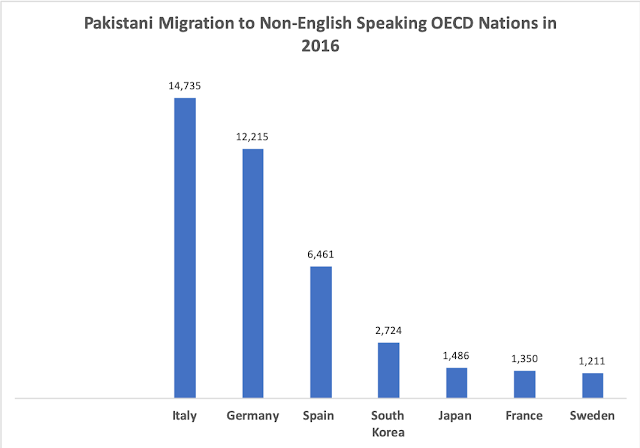 |
| Pakistani Migration to Non-English Speaking OECD Nations in 2016. S... |
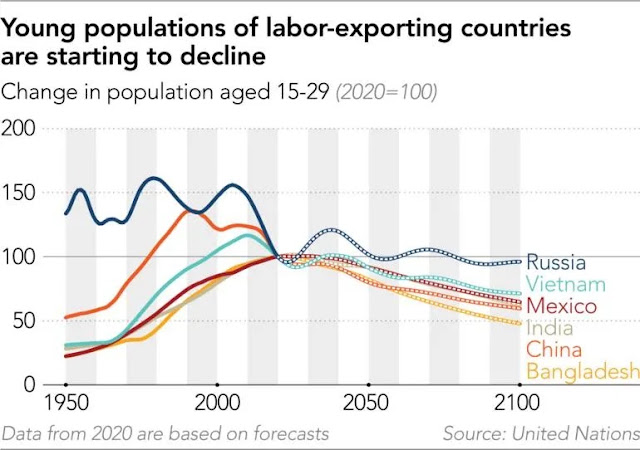 |
| Young Population Decline in Major Labor Exporting Countries. Source... |
Internal Migration:
Internal migration in Pakistan far exceeds external migration. Estimates from the 2014-2015 Labor Force Survey (LFS) indicate that the internal migrant population is roughly four times larger than the emigrant population. This means that some 13% of the Pakistani population is an internal migrant, according to Pakistan Migration Snapshot published in August, 2019.
Like most developing nations, the internal migration in Pakistan is linked to the differences in level of development between urban and rural regions with people moving for better employment and to overcome poverty. Pakistan has also experienced many natural hazards, which have caused numerous waves of internal displacement and internal migration (Sadia et al., 2017; Cibea et al, 2013).
Summary:
Pakistan is in the midst massive migration, both internal and external. Over half a million Pakistanis are migrating overseas while about 2 million are migrating internally from rural to urban areas. These trends are transforming the nation. Overseas remittances are soaring. Pakistan is becoming more urban. The country is also seeing growing foreign cultural influences from both the West and the Middle East.
Related Links:
Haq's Musings
South Asia Investor Review
Pakistan is the 7th Largest Source of Migrants in OECD Nations
Pakistanis Mini-Invasion of China
Inspirational Story of Karachi Rickshaw Driver's Daughters
Pakistan Remittance Soar 21X
Pakistan's Growing Human Capital
Two Million Pakistanis Entering Job Market Every Year
Pakistan Most Urbanized in South Asia
Hindu Population Growth Rate in Pakistan
Do South Asian Slums Offer Hope?
-
Comment by Riaz Haq on December 28, 2019 at 12:28pm
-
At 17.5 million, Indian diaspora largest in the world : UN report
India's leading country of origin of international migrants with a 17.5 mn strong diaspora, a UN report said.
Migrants from Mexico constituted the second largest diaspora (11.8 million), followed by China (10.7 million), Russia (10.5 million), Syria (8.2 million), Bangladesh (7.8 million), Pakistan (6.3 million), Ukraine (5.9 million), the Philippines (5.4 million) and Afghanistan (5.1 million).
At the country level, about half of all international migrants reside in just 10 countries, with the United States of America hosting the largest number of international migrants (51 million), equal to about 19 per cent of the world's total.
Germany and Saudi Arabia host the second and third largest numbers of migrants (13 million each), followed by Russia (12 million), the United Kingdom (10 million), the United Arab Emirates (9 million), France, Canada and Australia (around 8 million each) and Italy (6 million).
https://economictimes.indiatimes.com/nri/nris-in-news/at-17-5-milli...
-
Comment by Riaz Haq on December 28, 2019 at 4:44pm
-
Pakistan at a crossroads
Nuno Lopes | Shahid Farooq Updated December 28, 2019
https://www.dawn.com/news/1524873/pakistan-at-a-crossroads
WITH over 200 million inhabitants, Pakistan stands at a crossroads. Recovering from a devastating surge of terrorism, it is now in its third consecutive democratic government.
--------
Traffic congestion and air pollution are common features in Pakistan today, and rapid urbanisation has created under-resourced urban settlements, causing unprecedented levels of economic, spatial, social and infrastructural challenges.
Urban settlements are the engines of growth and development, and, therefore, they can make or break a country’s sustainability. Pakistan is experiencing a turning point in sustainability, with many areas at the lowest ebb of urban crisis. In the UN 2018 e-government index for 2018, Pakistan’s largest city Karachi was ranked as the lowest among 40 cities of the world assessed for resilience and sustainability through e-governance.
This makes a holistic and integrated vision of urban challenges more necessary than ever. In this context, a smart sustainable cities paradigm has emerged worldwide as a solution to these challenges. As defined by the Operating Unit on Policy-Driven Electronic Governance of the United Nations University, a smart sustainable city is one that implements a transformative governance process, oriented at building capacities to solve multidimensional and complex problems, conducted within a multidisciplinary team and with the collaboration and cooperation of all stakeholders, aiming to achieve sustainable economic, social and environmental development.
Pakistan’s major cities are exactly at the threshold where policymakers have no choice but to adopt this concept. Implicitly, Pakistan Vision 2025 already suggested a smart city transformation, by stating that it “seeks to ensure that Pakistan’s cities are digitally connected [and] equipped with wireless network sensors ... thereby laying the foundations for the cities of Pakistan to be smart and creative”. However, this is still a very simplistic smart city vision, as it is based only on technologies and does not mention the need to build capabilities and competences for solving urban problems.
This narrow understanding of the smart city concept limits its practical implementation. Countries under these circumstances tend to be more easily influenced by multinational IT companies or by more developed countries, which want to sell their solutions as though they are a universal remedy. To be effective, the smart city concept must be understood, absorbed and implemented by Pakistani citizens, as they are the ones who know better what they need and want for their future.
Pakistan cannot afford to lose momentum or else it will run the risk of definitively losing its competitiveness in the region as well as globally. Given that its neighbours China and India are much more advanced in the field of smart cities, with very ambitious national plans and tech innovation hubs, Pakistan has to seize the opportunity to become more economically competitive and sustainable.
The country has favourable factors that can enable and boost a fast transformation. First, it can harness the opportunities offered by CPEC; second, it has a good ICT infrastructure, with 100 per cent 3G/4G mobile coverage, which can be used to implement smart technological solutions; and third, cities such as Lahore, Peshawar and Multan have a very rich cultural heritage, and these unique features can have a catalyst effect. In addition, these cities have a flourishing IT industry with a growing number of IT parks, data centres and innovative tech incubators which can attract international investors.
-
Comment by Riaz Haq on December 31, 2019 at 9:14am
-
Legal Permanent Residents (Green cards) from Pakistan in Q1 of FY19 (Oct-Dec 2018)
Status Adjustment (of Pakistanis already in US) 1,270
New Arrivals (Pakistanis) in US: 2,233
Total From Pakistan: 3,503
Total From Bangladesh: 4,622
Total From South Korea: 4,782
Total From Vietnam: 9.693
Total From Philippines: 11,161
Total From India: 13,799
Total From China: 15,582
Total From Asia: 90,686
https://www.dhs.gov/immigration-statistics/special-reports/legal-im...
-
Comment by Riaz Haq on December 31, 2019 at 9:49am
-
DEMOGRAPHIC SNAPSHOT OF SOUTH ASIANS IN THE UNITED STATES
April 2019
http://saalt.org/wp-content/uploads/2019/04/SAALT-Demographic-Snaps...
Over 9.5% of green card recipients in FY 2017 were from South Asian countries: Bangladesh (14,693); Bhutan (2,940); India
(60,394); Nepal (11,610); Pakistan (17,408); and Sri Lanka (1,627).
The South Asian American community grew roughly 40% between 2010 and 2017. (See Table 1) The Nepali community
experienced the most significant growth, increasing by 206.6% followed by Indian, Bhutanese, Pakistani, Bangladeshi, and
Sri Lankan populations.
By 2065, it is projected that Asian Americans will be the largest immigrant population. The term immigrant refers to 2
individuals living in the United States but were not U.S. citizens at birth and necessarily all individuals who trace their
ancestry to a country outside of the United States. Bhutanese (92%) and Nepalese (88%) communities have the highest
foreign-born shares, followed by Sri Lankans (78%), Bangladeshis (74%), Indians (69%), and Pakistanis (67%)
Citizen Voting Age Population (CVAP) describes the total South Asian American population that is eligible to vote.30
Bangladeshi - 69,825
Bhutanese - 1,242
Indian - 1,558,594
Nepalese - 18,931
Pakistani - 222,252
Sri Lankan - 22,161
Changes in South Asian American Population, 2010 to 2017
Single Ethnicity Reported4 Multiple Ethnicities Reported5
2010 2017 Percent
Change
2010 2017 Percent
Change
Bangladeshi 142,080 176,229 24% 147,300 185,622 26%
Bhutanese 18,814 23,904 27% 19,439 26,845 38.1%
Indian 2,918,807 4,094,539 40.3% 3,183,063 4,402,362 38.3%
Maldivian 102 N/A N/A 127 N/A N/A
Nepali 57,209 171,709 200.1% 59,490 182,385 206.6%
Pakistani 382,994 499,099 30.3% 409,163 544,640 33.1%
-
Comment by Riaz Haq on January 1, 2020 at 5:20pm
-
17 million #Indian #emigrants abroad, up from 7 million in 1990, 143% increase. In this period, #India’s per capita #income increased by 522% ($1,134 to $7,055), providing more people the means to travel abroad in search of better #employment. #NRI #Modi https://www.business-standard.com/article/current-affairs/as-india-...
As India has become wealthier, more of its citizens are leaving its shores. An estimated 17 million Indians were living abroad in 2017, making India the largest source country for international migrants globally, up from 7 million in 1990 and a 143% increase, according to an IndiaSpend analysis of data from the United Nations Department of Economic Affairs.Over the same period, India’s per capita income increased by 522% (from $1,134 to $7,055), providing more people the means to travel abroad in search of employment opportunities they were not finding at home.
At the same time, the number of unskilled migrants leaving the country has been falling: An estimated 391,000 left India in 2017, almost half the number in 2011 (637,000), according to a new report by the Asian Development Bank (ADB).
However this does not necessarily mean that an increasing proportion of India’s emigrants are likely to be higher skilled or that policymakers should be worried about a rise in ‘brain drain’--the exodus of highly trained professionals from their native country.
The above figures refer to unskilled migrants travelling on Emigration Check Required (ECR) passports--passports issued by the Ministry of Overseas Indian Affairs to those leaving for employment in certain countries in the Middle East and Southeast Asia. Changes in the government criteria used to class workers as unskilled, leading to more migrants travelling on non-ECR passports, could be part of the reason for the declining trend.
“Over the years India has made internal adjustments to who gets an ECR passport. A lot of people are entitled to non-ECR passports and take that route to migrate instead--this is data which is not publicly available and therefore can not be analysed,” Seeta Sharma, Technical Officer (ILO) for EU-India Cooperation and Dialogue on Migration and Mobility, told IndiaSpend.
“It’s hard to say if more highly skilled people are leaving than in any other period and that ‘brain drain’ is increasing. Skills have increased across the board generally so the country may be losing higher skilled people compared to previous generations, but we’ve always had talent leaving the country to a large extent.”
International emigration generally rises with economic development as more people acquire the financial means to travel abroad, and only begins to reduce when countries reach upper-middle income status.
Labour demand driven by constrained local employment markets is a key motivation for international migration, with 73% of all migrants globally entering the workforce in their host country, the ADB report found.
India’s working age population is currently growing by 1.3 million each month, exacerbating a stagnant job market that is further afflicted by a lack of employment. As many as 20.8 million people applied for 90,000 available jobs with the Indian Railways, the country’s largest public-sector employer, the Times of India reported in March 2018.
Searching for a better life
Over almost three decades, between 1990-2017, India witnessed waves of skilled and unskilled labour emigration.
Indians living in the middle-eastern Arab state of Qatar increased 82,669%--from 2,738 to 2.2 million--over 27 years to 2017, more than in any other country.
In the two years between 2015-2017, the Indian population in Qatar more than tripled, rising by 250%.
Oman (688%) and the United Arab Emirates (622%) also feature in the top 10 countries for the largest increases in Indian residents between 1990-2017, while in Saudi Arabia and Kuwait, over seven years to 2017, Indian populations rose by 110% and 78% respectively.
These figures reflect the response of Indian workers to rapidly expanding economies in the Gulf, buoyed by rising oil prices. As these oil-rich nations embarked on large-scale development projects, workers from India and other South Asian countries answered the call for the growing number of construction jobs needing to be filled.
However, recent global economic slowdowns have slowed migrant flows from India into the region. Declining crude oil prices and the resulting spending cuts on construction projects and the slowing economies explain the falling numbers of Indians opting to travel to the region, as jobs dry up and wages contract, explained the Ministry of External Affairs 2016-17 annual report.
Italy stands out as a non-English speaking OECD country with the largest increase of Indian residents since 1990, making it the largest diaspora population in continental Europe.
This is largely due to several migrant amnesties in the 1990s and 2000s, when thousands of undocumented Indians gained residency status; many later brought over families through marriage. Italy is also one of the rare European countries to offer seasonal work visas to Indian citizens, augmenting its appeal as a destination country amongst migrants.
While traditional host countries for Indian migrants, such as the Gulf States, USA and UK, remain the countries with the highest Indian populations, over the last decade, OECD countries have seen a significant increase in the number of Indians choosing to settle within their borders.
Netherlands, Norway and Sweden, for example, have seen their Indian populations grow by 66%, 56% and 42%, respectively, over seven years to 2017--a result of cheaper (compared to US and UK) and better education and work opportunities after graduation.
“The UK has really made it difficult to find a job there after studying, so a lot of Indian students have been looking elsewhere,” Sharma said. “For example, Germany has free education and there’s the potential to land a job in the country after university too, so you’re seeing a shift in migration.”
Rapidly aging populations across Europe and the West will further create a demand for migrant labour, as imported workers fill employment gaps left by falling birth rates in many developed countries.
India is well placed to benefit from this demand, with a relatively skilled (especially given the mature local IT market) and English-speaking workforce.
“Some developed countries in the West simply don’t have the demographics to support their labour market and will need to depend on the rest of the world,” Sharma said. “India can be ahead of the game here.”
Half of all countries globally now have fertility rates below 2.1, meaning too few children are being born to maintain their population size, according to this 2017 study published in The Lancet, a medical journal.
In the short term, however, changing political environments and increasingly hostile attitudes to foreign migration may have an impact on the acceptability of Indian migrant workers taking up these jobs.
The Trump administration has vowed to clamp down on the number of H-1B visas issued to foreign workers (India currently receives 80% of the total issued)--in a bid to “put American workers first” and ensure the temporary visas are only issued when there is a clear need for a non-US citizen to be employed, said a 2017 statement by the U.S. Citizenship and Immigration Services.
Meanwhile the UK’s decision to leave the EU in 2019 has resulted in a 1.4% decline in skilled migrants, with the intake from Asia dropping 4.9%, according to the ADB report.
A changing emigration picture
The identity and socio-economic background of Indian emigrants is changing.
Southern states like Kerala and Tamil Nadu have been traditional sources of migrant workers to the Middle East and South-East Asia, departing on ECR passports. However, in recent years, northern Indian and less economically advanced states have overtaken their southern counterparts for the numbers of typically low-skilled male youth leaving for overseas work.
Uttar Pradesh took the lead for the highest number of emigrants since 2011, followed by Bihar and Tamil Nadu, while the number of migrants from Kerala declined 69% over six years, from around 80,000 in 2011 and 2013 to under 25,000 in 2017.
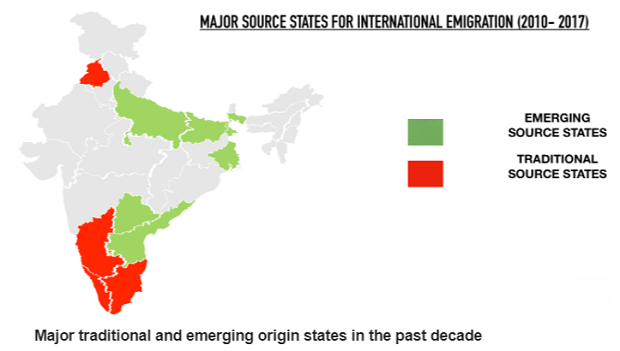
Source: India Migration Watch
Unequal levels of development and vastly different labour markets across the country mean not all Indian job seekers are motivated to move abroad for low-skilled labour opportunities.
While certain states in India, mainly in the south, such as Goa, Kerala and Tamil Nadu, have education, health and economic indicators similar to developed countries, others mirror those found in low-developed countries, IndiaSpend reported in July 2018.
“Migration trends have shifted,” Sharma said. “For example if you’re from Kerala it may no longer be so lucrative to go to the Gulf. But for someone sitting in Bihar earning a third of what a Keralite earns, it still makes sense.”
Emigration Check Required Migration From Top 10 Sending States (2011–2017) 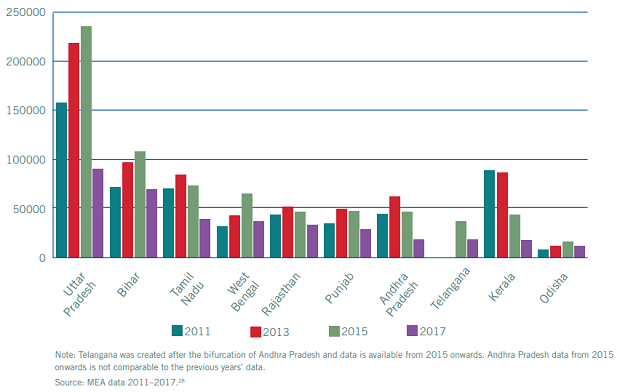
Source: India Labour Migration Update 2018, International Labour Organisation
However, while these data show the numbers from each state leaving on ECR passports, they do not indicate how many have switched to non-ECR passports. Kerala may still be seeing large numbers of its population emigrate despite a decline in 2016 and 2017 in the ECR category, according to this 2018 report by the International Labour Organisation.
Indeed, Kerala received 19% of all remittances (funds sent by an expatriate to their country of origin) received in India in 2016-17, closely followed by Maharashtra (17%) and Karnataka (15%), with all three states comprising 51% of total remittances, according to RBI data.
High poverty levels, unemployment and large wage differences between source and destination countries influence migration decisions.
Remittances are often vital income for workers’ families: 59% of remittances received in 2016-17 in India were used for maintenance (e.g. general consumption and living expenses), 20% were deposited in banks and 8% used to invest in property and shares.
India received the largest remittances in 2017 globally (the country has the largest number of international migrants, 7 million more than China), with close to $70 billion landing in the country’s banks accounts.
India is also becoming a major host economy for intraregional migrants--those who are originally from and moving internationally within Asia. In 2017, India recorded 5 million intraregional migrants, followed by Thailand (3.5 million), Pakistan (3.4 million), Australia (3.2 million), and Hong Kong, China (2.7 million).
These migrants are largely the low-skilled populations of neighbouring countries such as Bangladesh and Nepal, who have a shared history with India, cultural and linguistic affinities and a porous border.
However, unlike protective measures implemented through ECR passports and efforts made by the Indian government to ensure its citizens avoid exploitation in the Gulf, there are concerns that similar policies addressing immigrant welfare in the country have not been fully addressed.
India has recently sought to crackdown on illegal immigration in the country, with the publication of a draft National Register of Citizens in Assam, a state that borders Bangladesh and has seen large influxes of refugees since the war for Independence in 1971. The move caught media attention for initially leaving out 13 million names, the majority Muslim, and drove families to fear they would be deported.
-
Comment by Riaz Haq on January 3, 2020 at 11:04am
-
#Qatar seeks operational workforce from #Pakistan for World Cup 2022. Pakistan would send retired military officers (#security), traffic control, #hospitality and #IT #professionals for #FIFA World Cup 2020. #remittances https://www.brecorder.com/2020/01/03/558549/qatar-seeks-operational...
FIFA World Cup 2022, which is scheduled to be held in Qatar has shifted from construction and development stage to operational stage. “We sent workforce pertaining to development and construction skill, there is a bit of break of one, two months at the moment, after which we are sending workforce specialised in operational skills," said Bukhari, while talking to media.
The SAPM said that they would be sending retired military officers, traffic control, hospitality and IT professionals. “We are a top priority for Qatar's FIFA 2022 World Cup," he said.
Talking about employment opportunities for Pakistanis in Japan, the SAPM informed that Pakistan was among the first country to sign a MoU with Japan for manpower.
According to the data shared by the Bureau of Emigration and Overseas Employment (BEOE), in 2019, the overseas employment of Pakistanis witnessed a massive increase of 47 per cent as some 563,018 Pakistanis found jobs overseas while only 382,439 went abroad for different employment opportunities in 2018.
Manpower export to Saudi Arabia registered a marked growth of 191 per cent in 2019 as compared to the last year when only 100,910 Pakistanis went there. Moreover, the United Arab Emirates (UAE), Oman, Qatar, Malaysia and Bahrain also imported a whooping number of Pakistanis in 2019. The UAE employed 195,241 Pakistani workforce, Oman 26,062, Qatar 17,413, Malaysia 10,390 and Bahrain 6,988 during the said year.
As per Overseas Pakistanis & Human Resource Development ministry the total number of emigrants who got foreign employment in 2019 included 45.5 percent skilled, 39.72pc unskilled, 10.64pc semi skilled, 2.53pc highly qualified and 1.56pc highly skilled workforce.
-
Comment by Riaz Haq on January 16, 2020 at 1:04pm
-
Why do 30,000-40,000 #migrants from #Pakistan head to #Europe every year? Prof Andreas Schloenhardt: Pakistan has a strong #expat community abroad; many #Pakistanis have family abroad, so they hope to join their families. #migration https://www.infomigrants.net/en/post/22133/why-do-migrants-from-pak... via @InfoMigrants
According to estimates by the Pakistani authorities, some 30,000 to 40,000 people from Pakistan attempt illegal passage to Europe via Iran and Turkey every year. InfoMigrants spoke to an expert to find out which factors lead to this trend.
InfoMigrants: What are the main causes that force people from Pakistan to undertake perilous journeys towards Europe?
Andreas Schloenhardt: The causes are complex and involve lots of factors from the Pakistani context; such as slow economic development, a fragile security situation, regularly occurring natural disasters and political instability. This leads to a scarcity of opportunities for higher education and skilled employment. In addition, Pakistan has a strong expat community abroad; many Pakistanis have family abroad, so they hope to join their families.
The majority of migrants heading to European countries tend to come from the Gujrat district in Pakistan’s western Punjab province. This trend has persisted for several decades now. How effective will legislation prove to be in limiting illegal migration from Pakistan?
In many parts of Pakistan, economic development and job opportunities are very limited and those are the main reasons for migration. Any laws or other measures to combat smuggling of migrants and close migration routes do nothing to address the main causes of migration and displacement. What is needed, are laws that manage and regulate emigration from Pakistan and entry into other countries, as well as mechanisms to facilitate the return of Pakistani nationals.
Pakistan has a labor migration policy that seeks to assist and protect Pakistani nationals seeking employment abroad (mostly in the Gulf region). This is however rarely matched by legislation in the receiving countries that control and manage incoming labor migrants. Much can be done on that front to push irregular migration into legal avenues.
Furthermore, many Pakistanis found to be in Europe unlawfully cannot just be returned to Pakistan as the country is slow at, and sometimes refuses to issue travel documents. Plus, quite a few countries don’t have any agreements with Pakistan to facilitate the return of migrants.
Smuggling of migrants is what they call a trans-national crime. Is anything being done at a trans-national level to combat this crime and to apprehend networks of smugglers who are spread across many regions and countries?
There are ample international initiatives to prevent and combat the smuggling of migrants on the international level. Chief among them is the Protocol against the Smuggling of Migrants. Regrettably, the problem of migrant smuggling seems to be receiving less attention from European governments now than compared to three or four years ago; only a few states actively engage in forums to make the protocol function and enhance international cooperation.
Furthermore, too little is being done to stop the smuggling of migrants overall. The Global Compact on Migration that came into force a year ago also provides durable solutions to stop smuggling of migrants, along with other forms of irregular migration. But, once more, many states are slow to implement meaningful responses; many remain hostile to them. The responsibility and fault here squarely rests with individual states, not with international organizations that stand ready to assist individual states.
Stopping smuggling of migrants seems not to be a priority in Pakistan - a country struggling with political instability, terrorism and a weak economy. Is this correct?
-
Comment by Riaz Haq on February 17, 2020 at 6:00pm
-
Remittances to #Pakistan jump over 9% in January 2020 totaling $1.90 billion vs $1.744 billion in Jan 2019. #Remittances for July-January period of current FY $13.3 billion vs $12.77 billion in prior fiscal year, an increase of 4.1%. https://www.khaleejtimes.com/business/remittances-to-pakistan-jump-...
During January 2020, remittances received from Saudi Arabia fell 8.4 per cent to $433.4 million while Pakistani nationals in the UAE remitted $395.5 million, a decline of 7.5 per cent.
Remittances from the other major markets such as the USA and UK fell 6.3 per cent and 7.9 per cent to $335.1 million and $299.1 million, respectively.
---
Moreover, the State Bank of Pakistan also hiked payment limits against freelance services for an individual in computer and information systems and other freelance services from $5,000 per month to $25,000 in order to attract more foreign exchange.
"The enhancement in limit will facilitate freelancers to route greater value of funds through a more economical and efficient channel of home remittances and help in receiving foreign exchange flows through formal banking channels in the country. This would also enable freelancers to expand their business/ operations and engage new freelancers to join the workforce," the central bank said in its statement.
---------------------
Moody's: Rising workers’ #remittances bode well for #Pakistan #economy. In 2012-19 period, remittances rose at a compounded annual rate of nearly 9%, with majority of inflows coming from #GCC (54%), #US (16pc), #UK (16pc) and #Malaysia (7%). https://profit.pakistantoday.com.pk/2020/02/17/increase-in-workers-... via @Profitpk
An increase in worker’s remittances is positive for Pakistani banks and borrowers, as it supports deposit flows and strengthens household finances, according to the credit rating agency Moody’s.
In a report published on Monday, the agency said that the high levels of remittances have contributed to reported double-digit growth in residents’ household deposits.
Earlier on 12 February, the State Bank of Pakistan (SBP) released updated monthly data on workers’ remittances, which showed a 4pc increase in the monthly average for the fiscal year 2020, compared to the previous corresponding year.
According to SBP data, workers’ remittances received during the first seven months of FY20 amounted to a cumulative total of $13.3 billion.
The agency noted that the growth [in remittances] has provided a stable and low-cost deposit base to Pakistani banks, which in turn has enhanced banks’ profitability and increased their liquidity buffers.
The report further stated that the growth might help mitigate the effect of government deposit outflows. The SBP is considering introducing a Treasury Single Account, which will require government deposits to be placed with the SBP instead.
Despite Pakistan’s high-interest rates (unchanged since July 2019 at 13.25pc), the remittances have helped negate any associated challenges. That’s because households are better positioned to meet their financial obligations with banks.
Non-performing loans have also been maintained at historically low levels; consumer NPLs accounted for 5pc of total consumer loans as of the end of September 2019, while the system average NPL ratio was 8.8pc.
According to the World Bank, Pakistan was the seventh-largest recipient of remittances globally in 2018, with remittances inflows reaching $21 billion or 6.8pc of the country’s GDP.
-
Comment by Riaz Haq on August 24, 2020 at 10:38am
-
#Pakistani diaspora bails out #Pakistan #economy. Account surplus of $424m in July 2020 vs current account deficit (CAD) of $613 million in July 2019. Remittances from diaspora reached monthly record $2,768 million in July 2020 #ImranKhan #PTI #COVID19 https://www.dawn.com/news/1576206
According to data released by the State Bank of Pakistan (SBP) last week, the country received record-high remittances of $2.768 billion in the first month of the new fiscal year, following the record $23bn received during the outgoing financial year.
“This ($2.768bn) is the highest-ever level of remittances in a single month in Pakistan,” SBP had said.
“More good news for Pakistan economy,” Prime Minister Imran Khan had tweeted last week. “Remittances from overseas Pakistanis reached $2768 million in July 2020, highest ever amount in one month in the history of Pakistan.”
Separately, Planning Minister Asad Umar also lauded the current account surplus for July 2020 in a tweet today, recalling that the PTI government had "inherited" a deficit of $2 billion "as a legacy of PML-N", which was in power until 2018.
"Remember the current account deficits have led to massive external debt and compromises our independence and security," he added.
Earlier this month, while quoting data released by the Finance Ministry, Dawn had reported that since the PTI came to power, CAD had been brought down from $20bn to $3bn while exports were up despite Covid-19 demand stagnation while cost of borrowing had been brought down due to better debt management.
-
Comment by Riaz Haq on September 22, 2020 at 11:26am
-
Migrant workers from Asia’s developing countries have managed to send home record amounts of money in recent months, defying pandemic expectations and propping up home economies at a critical time.
Remittance doomsayers see something else in the bigger-than-usual transfers: a coming crash, triggered by a bleak job market, particularly in the Middle East. As they see opportunity drying up along with demand for oil, workers are sending money home in advance of their own return.Unlike Latin American countries, which continue to benefit from a tentative U.S. recovery, Asian countries are vulnerable to economic austerity in Saudi Arabia and elsewhere in the Middle East. More than 60% of remittances to India, Bangladesh and Pakistan come from Gulf Cooperation Council countries, said Khurram Schehzad, chief executive officer at Karachi-based advisory Alpha Beta Core Solutions Pvt. The region is also the top destination for workers from the Philippines, lone of the world’s largest suppliers of overseas labor.
Saudi Arabia has already raised taxes and import fees to make up for falling oil revenue. Job cuts in the kingdom appear to target foreigners first, with Riyadh-based Jadwa Investment estimating more than a million foreign workers will leave the labor market this year.
After eight years of sending money to family in Karachi, Abdul Hanan Abro is one of the workers who will follow his money home. He was laid off from his acc ..He was laid off from his accounting job in Dubai in May and hasn’t found a new gig -- and he’s not the only one. “No one is getting anything,” said Abro. “Two to three of my friends have already moved back to Lahore. People are selling their cars and stuff, doing their final settlements.”
For Abro, coming home means starting over. He wants to use the savings he accumulated overseas to start a business. “It’s high time to just focus on what I was planning for two to three years now,” Abr ..coming home means starting over. He wants to use the savings he accumulated overseas to start a business. “It’s high time to just focus on what I was planning for two to three years now,” Abro said. “It’s better than wasting more time in finding a job in this market.”
In April, the World Bank predicted overseas workers would send home 20% less this year, the biggest drop since at least 1980. The lender hasn’t updated its forecast to reflect the recent resilience, but a decline is still ..“People are returning home,” said Thomas Isaac, the finance minister for Kerala, which accounts for the country’s largest share of remittances. “Therefore, they bring back all their savings.” India is the world’s top recipient of transfers and a leading supplier of labor to the gulf; it took in $83 billion last year, exceeding the $51 billion it took in as foreign direct investment.
Overall, remittances to the Asia-Pacific region will drop 12% in the second half of 2020 compared with th ..Kerala’s proud record for near-total literacy gave its citizens a leg-up over other Indians — not to mention Pakistanis, Bangladeshis and others — seeking jobs in the Gulf. Despite their better education, the overwhelming majority of Keralites did jobs that indeed required being “roasted in the desert sun,” as Dad put it. In the classic migration pattern, young men endured great physical hardship and forewent luxuries to save up, remit money home and bring over friends and relatives. The steady ..
Twitter Feed
Live Traffic Feed
Sponsored Links
South Asia Investor Review
Investor Information Blog
Haq's Musings
Riaz Haq's Current Affairs Blog
Please Bookmark This Page!
Blog Posts
Happy New Year 2026: Pakistan's Year 2025 in Review
As we enter the year 2026, it is time to review the year 2025 and wish you all Happy New Year 2026! May it bring peace, prosperity and happiness to all!!
The year 2025 saw Pakistan defeat a brazen Indian attack on its soil, while reviving its economy and…
ContinuePosted by Riaz Haq on December 30, 2025 at 9:30pm — 3 Comments
PIA Privatization: Can it Bring Back Pakistan National Airline's Glory Days?
After decades of failed attempts, the Government of Pakistan has finally privatized the Pakistan International Airline (PIA) under intense pressure from the International Monetary Fund (IMF). Nonetheless, it is a deal that will give the national airline not only a chance to survive but to thrive in the long run. As part of structuring the sale for Rs. 135 billion, the government has assumed Rs. 654…
ContinuePosted by Riaz Haq on December 25, 2025 at 10:30am — 6 Comments
© 2026 Created by Riaz Haq.
Powered by
![]()

You need to be a member of PakAlumni Worldwide: The Global Social Network to add comments!
Join PakAlumni Worldwide: The Global Social Network